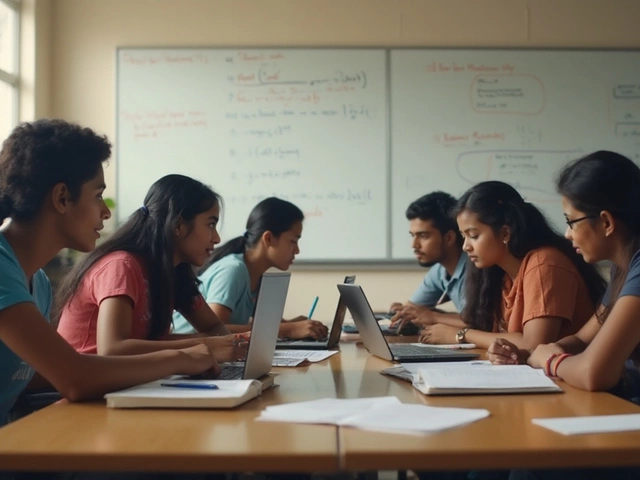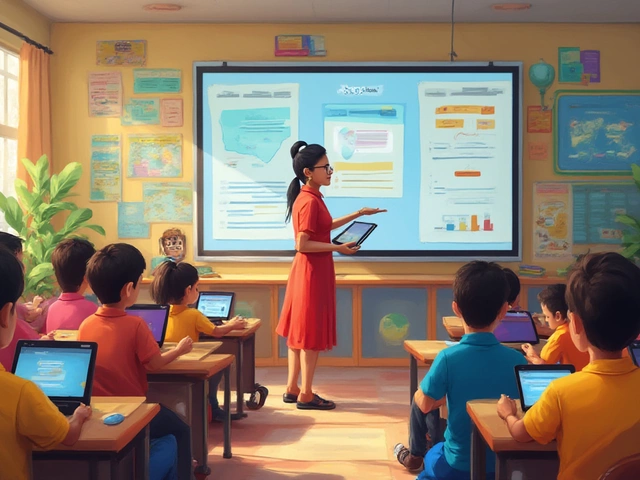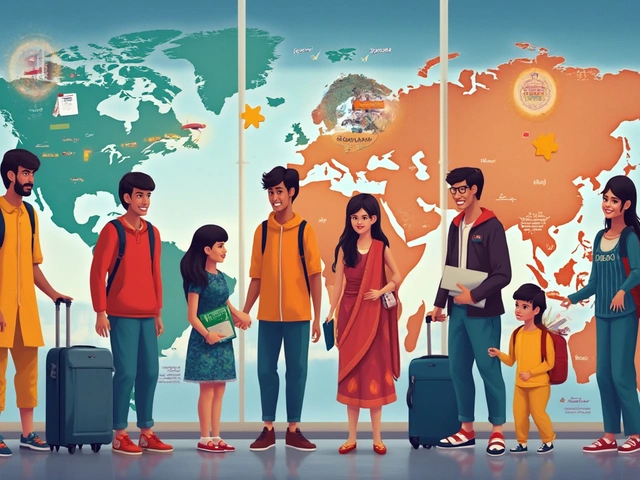Still think CBSE is just a Delhi board? You’re not alone. I’ve lost count of how many times people around me have called CBSE “the Delhi board,” as if it caters only to kids in the national capital. The truth is a bit different—and honestly, way more interesting if you care about picking the right school for your child.
Let’s cut through the rumors. CBSE stands for Central Board of Secondary Education. The word 'Central' is key here. It's managed by the Government of India, not just the Delhi government. Sure, the main office sits in Delhi, but that doesn’t make CBSE a local, Delhi-only thing. Think of it like a central hub that sends out standards to thousands of schools, not just one city's worth.
Confused why people lump CBSE with Delhi? Some of it comes from history. Yes, it started in Delhi ages ago. But just because the first building went up there doesn’t mean the board stopped at the city’s border. Now, schools that follow the CBSE syllabus are everywhere—in big metro cities, in small towns, and even outside India in places like Dubai or Singapore.
- Where Did CBSE Come From?
- Why People Call It a Delhi Board
- CBSE’s National and Global Presence
- How CBSE Connects Schools Across India
- CBSE Syllabus: Who Should Consider It?
Where Did CBSE Come From?
Most people don’t realize just how old the CBSE actually is. It started way back in 1929 under the name 'Board of High School and Intermediate Education, Rajputana.' Back then, it was set up to serve a few regions—mainly Ajmer, Merwara, Central India, and Gwalior. Fast forward a decade, and it got a bigger role, as more states joined in and needed a solid central board.
A lot changed after India gained independence. In 1952, the Indian government restructured the board and gave it the name we all know: Central Board of Secondary Education (CBSE). They wanted one central system schools across the country could trust for things like exams, curriculum, and teacher qualifications.
So, why Delhi? Simple: Delhi is the capital, and that made it handy for the Indian government to set up the headquarters there. But from day one, the idea wasn't for CBSE to just stick around in the capital. It was always supposed to set nation-wide standards. Today, the board’s office is in Delhi, but its rules, exams, and textbooks reach way beyond.
Just to get a sense of the growth, check out these numbers:
| Year | Number of CBSE Schools |
|---|---|
| 1962 | 309 |
| 1980 | 500+ |
| 2024 | Over 28,500 |
That’s a huge jump from a handful of schools to thousands not only across India but also abroad. The idea was never just to be a Delhi board. CBSE was built for the whole country from the start, and the numbers prove it’s pretty much everywhere now.
Why People Call It a Delhi Board
If you grew up hearing relatives say, “CBSE? That’s the Delhi board!”—you’re definitely not alone. The reputation sticks, even though it’s not really true anymore. So, what’s the story?
First big reason: the CBSE headquarters has always been in Delhi. That’s its main office, where all the major decisions are made and the top officials work. This one address factor has led a lot of folks to assume everything about CBSE is tied up with Delhi.
Second, when CBSE started in 1929, it was called the “Board of High School and Intermediate Education, Rajputana.” Over time, it moved its base to Delhi—especially after independence. By 1962, the ‘Central Board of Secondary Education’ got its current name, but the Delhi address stayed. Since schools in Delhi were the earliest to be affiliated, the label followed.
Here’s a little data snapshot to show how this idea grew:
| Year | Number of CBSE Schools in Delhi | Number Nationwide |
|---|---|---|
| 1971 | 90 | 270 |
| 2000 | 415 | 7,215 |
| 2023 | 1,300+ | 28,700+ |
It’s clear: while growth exploded across India, Delhi schools were always prominent. That just reinforced the Delhi image. Also, if you check exam centres and headquarters address, it’s always “Delhi,” which makes people outside Delhi think the board isn’t for them.
One more thing—many government and top private schools in Delhi use the CBSE syllabus. That means when someone says they study in a “CBSE school,” chances are you’ll picture a Delhi kid first. But the reality is, lakhs (hundreds of thousands) of students from all over India follow the same syllabus and take the same exams.

CBSE’s National and Global Presence
The reach of the CBSE board honestly blows people away once they see the numbers. Right now, CBSE is connected with over 27,000 schools all across India. That includes some of the most popular schools in big cities like Mumbai, Bangalore, and Chennai, but also schools in towns and districts you might never have heard of. The idea behind this is standardization—no matter where you are in India, students get the same CBSE syllabus, the same exam pattern, and the same rules.
But it doesn’t stop at India’s border. There are more than 240 CBSE-affiliated schools in 28 countries outside India. You’ll find CBSE schools in the UAE, Singapore, Nepal, Saudi Arabia, and even Russia. These international schools use the same textbooks and exams as schools in India.
| Region | Number of CBSE Schools |
|---|---|
| India | 27,000+ |
| International | 240+ |
This wide network is exactly why CBSE is the preferred board for families who move between cities or even countries. Parents don’t have to stress about their child missing out or struggling with a totally different curriculum. The flexibility makes transitions smoother, and it gives CBSE students a consistent educational experience, no matter where they are.
It’s also why many Indian embassies and expats stick with CBSE for their own kids when living abroad. With one central authority, you get reliable updates, unified exams, and official recognition almost everywhere in India. The board isn’t stuck in the past either—CBSE often updates its curriculum to fit modern trends, so students can stay current with what’s important right now, not just what mattered fifty years ago.
How CBSE Connects Schools Across India
People call it a "Delhi board," but the CBSE has set up networks all over the country. As of 2024, more than 28,500 schools in India run on the CBSE syllabus. That’s not just in big metro cities—think small towns in Assam, remote spots in Himachal, and crowded areas in Maharashtra. Even in Andaman and Nicobar, you’ll find CBSE schools.
School groups—from Kendriya Vidyalayas (the central government schools) and Jawahar Navodaya Vidyalayas to top private chains like DPS—rely on CBSE guidelines. The board keeps them on the same page by:
- Releasing a standardized curriculum across all subjects, so whether you're studying math in Bengaluru or English in Agra, you follow the same format.
- Setting exam patterns and dates, which means board exams happen simultaneously for everyone.
- Offering teacher training sessions, updated materials, and regular circulars through an online portal accessible to all affiliated schools.
- Making it easy for students to switch from one CBSE school to another, even across states—handy for government employees or families who move around a lot.
The board isn’t just talking to these schools once a year. They run online communities, organize training webinars, and even help organize sports and cultural events that rope in kids from all over India. There’s a steady stream of updates, workshops, and shared resources that keep every affiliated school in the loop.
| State/UT | Number of CBSE Schools (2024) |
|---|---|
| Uttar Pradesh | 3,700+ |
| Maharashtra | 2,000+ |
| Tamil Nadu | 1,250+ |
| Delhi | 1,100+ |
So, even if the headquarters is in Delhi, the CBSE network beats in schools from the southern tip of Kerala to Jammu up north. This reach brings a level of consistency that lots of parents (including me and Anaya) appreciate, especially if there’s a chance of switching cities in your career.

CBSE Syllabus: Who Should Consider It?
So, who really benefits from choosing the CBSE syllabus? This question keeps popping up, especially when parents sit down to compare different school boards. The most obvious answer: families who shift cities often. If your job moves you from Mumbai one year to Bangalore the next, it’s a relief to know CBSE schools follow more or less the same curriculum everywhere. No sudden jump in chapters or awkward gaps for your child.
Students aiming for competitive exams? They usually flock to the CBSE crowd. The reason is simple—entrance tests like JEE Main and NEET (for engineering and medical) pattern their questions after CBSE textbooks, especially for classes 11 and 12. In fact, nearly 90% of the core content in these exams traces directly to the CBSE syllabus. That’s no coincidence.
Also, the CBSE board updates its syllabus more often than some regional boards. This helps when it comes to changes in science, math, or language. Hindi and English are the only mandatory subjects, but you get plenty of flexibility to pick others, which works well if you want a balance.
- If you plan to move abroad, plenty of international schools also offer CBSE, making transfers easier.
- Kids who want a bit less pressure (compared to ultra-theoretical boards) find CBSE more student-friendly.
- Access to lots of school choices—there are more than 28,500 CBSE-affiliated schools, according to their 2024 report.
Just a heads-up: if your child is super-focused on local state history or regional languages, a state board might fit better. But if you want consistency, wide recognition, and an edge in national-level exams, CBSE is hard to beat.
| Feature | CBSE Board | State Boards |
|---|---|---|
| Number of Schools (2024) | 28,500+ | Varies by state |
| Entrance Exam Alignment | Highly aligned | Varies |
| Ideal for Families Who Move | Yes | Not usually |
| International Recognition | Good | Low |






Write a comment: